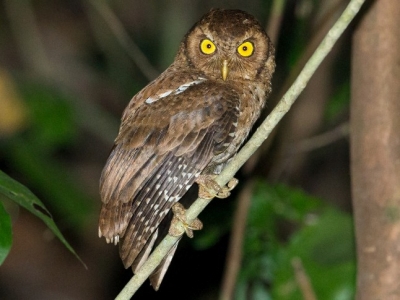
The Andaman scops owl, or Otus balli, is a small raptor which belongs to the family Strigidae. This rare owl is found only on India’s Andaman and Nicobar islands. It is a small, dark brown owl with striking bright yellow eyes and a yellow beak. It has pale, creamish flecks on its upper parts and its plumage may range from a bright reddish brown to dark brown.
It is found in forests and is strictly nocturnal like most owls. Its call is an accelerating repeated, ‘wup-up-up-upupup’.
This bird gets its scientific name from Valentine Ball, an Irish geologist and ornithologist. These birds are small and agile and have two colour variants – gray brown and reddish brown. Its facial disc is light brown and it has prominent ear tufts and whitish eyebrows.
As with most owls, its vision and hearing are acute, which makes this bird an excellent hunter. Did you ever wonder why owls rotate their heads to see? This is because their eyes are fixed in their sockets. To make up for this, owls have numerous vertebrae in the neck enabling them to turn their heads almost 360 degrees!
This owl prefers semi-open areas, cultivated lands and plantations near human settlements. It appears to tolerate disturbances from human activities rather better than other owl species. This owl eats caterpillars, beetles and other insects as well as insect larvae. Like parrots, it moves sideways to catch and eat caterpillars.
It nests in tree hollows and abandoned woodpecker holes and lays its eggs between February and April. Although it makes local movements for feeding and breeding, it does not migrate and is an endemic resident of the Andaman Islands.
This species is considered ‘Near Threatened’ because of its small range – it is found exclusively in the Andaman and Nicobar Islands. It is also threatened by the destruction of its habitat due to human activities in the Andaman Islands.
Picture Credit : Google




